![]()
Chapter V – Petrogenesis
and
Chapter VI – Geochronology
A Ph.D. Dissertation by Kyaw Thu
Department of Geology, University of Yangon, Myanmar
Copyright © Kyaw Thu, 2007
Introduction from Bill Larson, Pala International
Kyaw Thu is a FGA gemologist with a Ph.D. in Geology. Pala International knows him from trips in the mid-1990s as one of the most interesting young gem enthusiasts, among so many wonderful students and collectors we met. Both Will and Bill Larson consider him a special and close friend. He has helped answer many questions regarding locality information for Brendan Laurs of GIA as well as meeting in person Dr. George Harlow of the American Museum of Natural History and corresponding with him for almost a decade. He has opened a gem laboratory and has applied to GIA to further his education. I was given a copy of his PhD thesis last month and Dr. Harlow made it available by scan for interested parties. Pala International is honored to share this with our readers.
Contents
See full table of contents here.
Chapter V Petrogenesis
-
5.1 Origin of the Granitic Rocks
-
5.2 Origin of Alkaline Rocks
-
5.2.1 Origin of Nepheline Syenite
-
5.2.2 Origin of Urtite Series
-
-
5.3 Origin of Ultramafic Rocks
-
5.4 Emplacement and Depth of Intrusions
-
5.5 Metamorphic and Igneous Rocks History of the Area
Chapter VI Geochronology
List of Figures for Chapters V and VI (images from Pala International are not listed) |
|
| 5.1 | K2O vs SiO2 diagram for granitoids of the study area; distinction between oceanic plagiogranite and other granitoids from the other environment (after Maniar and Piccoli, 1989) |
| 5.2 | Al2O3 vs SiO2 diagram for granitoids of the study area (after Maniar and Piccoli, 1989) |
| 5.3 | MgO vs SiO2 diagram for granitoids of the study area (after Maniar and Piccoli, 1989) |
| 5.4 | Shand’s index diagram for granitic rocks of the area. Distinction between CCG and CAG+IAG (after Maniar and Piccoli, 1989) |
| 6.1 | (a) LA ICP-MS, (b) BSE image of zircon crystals, (c) LA ICP-MS technique |
| 6.2 | (a, b, c) Data interpretation processes of zircon dating in LA ICP-MS and SHRIMP techniques |
| 6.3 | (a, b) Data interpretation processes of zircon dating in LA ICP-MS and SHRIMP techniques |
| 6.4 | The concordia plot diagram of radiometric dating of augite-biotite granite (A-2) by LAICP-MS technique |
| 6.5 | Location map and 40 Ar/39 Ar diagrams of dated samples form high grade metamorphic and intrusive rocks of Mogok area; all the ages from this area are Early to Middle Miocene (after Bertrand et al., 2001) |
List of Tables |
|
| 6.1 | LAICP-MS: U-Pb zircon age data for leucogranite (LG-1) and zircon inclusion in painite, associate with ruby in leucogranite matrix (P-1) |
| 6.2 | Comparison of Rock Sequence in Southern Part of Mogok Stone Tract and the study area with radiometric ages |
Chapter V Petrogenesis
5.1 Origin of Granitic Rocks
5.1.1 Origin of Augite-biotite Granite
The occurrence of augite-biotite granite in the study area is very limited, discordant, with margins parallel to the foliation. Although, a ghost stratigraphy (i.e., relics of original bedding) is absent in these granites, petrographic data shows the presence of myrmekitic texture and a certain amount of zoning, indicating these granites are magmatic in origin.
The mineral composition of augite-biotite granite shows true granite composition and absence of granodioritic composition, and has probably resulted from the interaction or contamination of pyroxene bearing metacalcareous rocks of country rocks from this area. Internal foliation is often conspicuous and there are clear indications either that the augite-biotite granites were in existence [while] folding and metamorphism occurred.
According to field observation and petrochemical data (Figs. 4.9 and 4.20), it indicates that the augite-biotite granite is syn-kinematic granite. It should be pointed out, however, that the radiometric age of the augite-biotite granite suggests a prekinematic origin rather than a syn-kinematic origin.
5.1.2 Origin of Leucogranite
Leucogranite occurs widespread as small stocks and dykes. Felsic minerals are predominant, such as quartz and feldspar, [and] are found [with] intergrowth displaying graphic texture. The content of mafic is less than 3% (i.e., less of hornblende, biotite), it indicates fairly low water content in magma. Petrochemical data has been shown that the minimum temperature of the melts can be 680°C and PH2O is about 2 kb.
According to above factors, the leucogranite originated as a fairly dry melt granitic composition in original magma. Presence of sodic plagioclase (i.e., albite) as string perthitic veins in alkali-feldspar, and the liquidus temperature >660°C, indicate that the leucogranite falls in category of subsolvus type IIA of Tuttle and Bowen (1958). However, the occurrence of garnet in leucogranite suggests that the granite was formed by contaminating with metasedimentary rocks in this area. These are intruded into regionally metamorphosed rocks, and are accompanied by other plutonic rocks such as syenite and biotite microgranite. Relic bedding and other metamorphic structures are absent in these rock, which indicate that magmatic origin.
However, the presence of secondary foliation in the leucogranite does not agree with the late kinematic origin mentioned in section 4.3.2, because of the effects of the regional metamorphism. Marginal zone of leucogranite is discordant with country rocks in this area. The rock seems to have [been] particularly prone to alteration (i.e., kaolinization) by late-stage or pneumatolytic alteration processes (Hatch et al., 1961).
5.1.3 Genetic Types of the Granitic Rocks of the Area
The tectonic environment for the granitic rocks of the study area, can be studied according to Maniar and Piccoli (1989). They categorized the granitic rocks by tectonic environments as follows:
- Island arc granitoids (IAG)
- Continental arc granitoids (CAG)
- Continental collision granitoids (CCG)
- Post-orogenic granitoids (POG)
- Rift-related granitoids (RRG)
- Continental epierogenic uplift granitoids (CEUG), and
- Oceanic plagiogranite (OP)
The IAG, CAG, CCG and POG are considered orogenic granitoids, and the RRG, CEUG and OP are considered anorogenic granitoids.
The tectonic discrimination of granitic rocks is based on the major element chemistry. Various discrimination plots are presented which sequentially discriminate the different tectonic environments. The K2O vs SiO2 diagram (Fig. 5.1) shows the distinction between oceanic plagiogranite (OP) and other granitic rocks (IAG+CAG+CCG+RRG+CEUG+POG) from the other environment. The granitic rocks of the area fall in IAG+CAG+CCG+RRG+CEUG+POG field.
The Al2O3 vs SiO2 diagram (Fig 5.2), shows the distinction between group I (IAG+CAG+CCG), group II (RRG+CEUG) and POG augite-biotite granite falls within the field of (IAG+CAG+CCG), although leucogranite, biotite microgranite and pegmatite fall within the field of POG. MgO vs SiO2 variation diagram (Fig. 5.3), indicates the distinction between group I (IAG+CAG+CCG), group II (RRG+CEUG), and also POG field. The granitic rocks of the area fall in the IAG+CAG+CCG field.
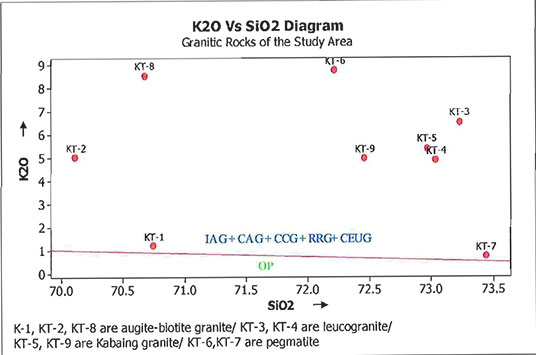 |
| Fig. 5.1. K2O vs SiO2 diagram for granitic rocks of the area; distinction between oceanic plagiogranite and other granitic rocks from the other environment (after Maniar and Piccoli, 1989) |
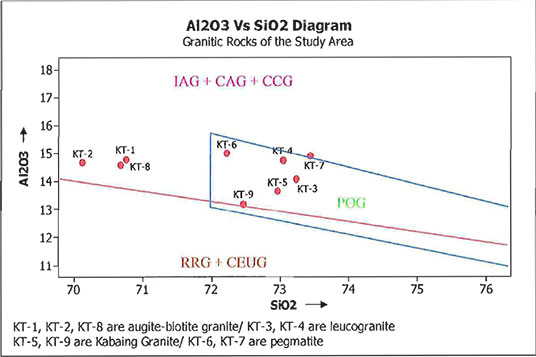 |
| Fig. 5.2. Al2O3 vs SiO2 diagram for granitic rocks of the area (after Maniar and Piccoli, 1989) |
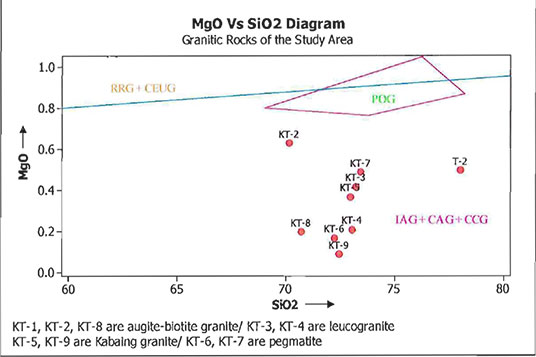 |
| Fig. 5.3. MgO vs SiO2 diagram for granitic rocks of the area (after Maniar and Piccoli, 1989). |
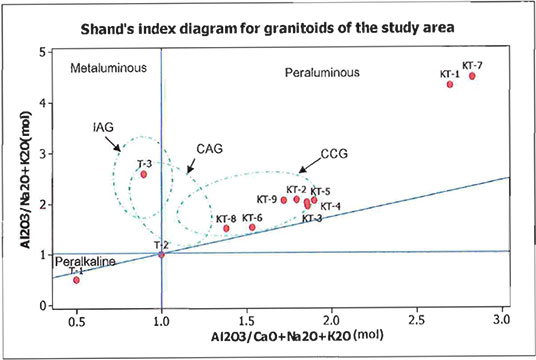 |
| Fig. 5.4. Shand’s index diagram for granitic rocks of the area. Distinction between CCG and CAG+IAG (after Maniar and Piccoli, 1989). |
According to the above diagrams and facts, it can be postulated that the granitic rocks of the area generally fall in the IAG+CAG+CCG field. However, in the Shand’s index diagram (Fig. 5.4), plots of the granitic rocks fall in the CCG field. In this case, the granitic rocks of the area may be regarded as continental collision granites.
The ACF diagram (Fig. 4.13) [shows] some distinctive chemical properties of the granitic rocks of the area, such as relatively low sodium content (Na2O are mostly < 3.2%); molecular ratio of Al2O3 and (Na2O+K2O+CaO) is (>1%); CIPW normative corundum is (mostly >1%); high SiO2 type and associated with cassiterite, scheelite mineral deposits; indicate that these granitic rocks are mostly S-type granites.
In Fig 4.20, the K2O mol. vs Na2O mol. diagram indicates that augite-biotite granite from the area falls in the field of syn-kinematic granite, although other granitic rocks such as leucogranite, Kabaing Granite and pegmatite fall in the field of late-kinematic granite. It should be pointed out, however, that the radiometric age of the augite-biotite granite suggests a pre-kinematic origin rather than a syn-kinematic origin (see section 6.3). The pre-kinematic origin of the augite-biotite granite as mentioned above is supported by the presence of pronounced secondary foliation in this rock.
Therefore, it can be considered that S-type or ilmenite-series granitic rocks of the study area, interpreted to originate in the lower to middle crust, where derivation from partial melting of sedimentary rocks would have caused enrichment in Al and depletion of Na2O and CaO, formed on the continent owing to the subduction of an oceanic plate beneath the continent, during the continent collision phase of an orogeny corresponding to the period following the collision of India with Eurasia.
5.2 Origin of Alkaline Rocks
[Regarding] the alkaline rocks of the area, only silicon is deficient and alumina is excessive. The (Na2O+K2O)/Al2O3 ratio is less than 1, thus according to Hyndman (1985) these alkaline rocks fall in the miaskitic type, i.e., not peralkaline. The alkali-lime index (Peacock index) (Figs. 4.5, 4.6) indicates calcic to alkalic-calcic character and also suggests (Figs. 4.10, 4.11) calc-alkaline with only partly alkaline character of igneous rocks from this area. The alkaline rocks of the study area includes quartz syenite, alkali-feldspar syenite, sapphire-bearing nepheline syenite, sapphire-bearing alkali-feldspar syenite pegmatite, quartz monzonite and urtite series. These rocks are frequently found in the area as dykes and small stocks as the result of assimilative contamanitive reactions.
It can be noted from Table 4.1 that the various rock types analysed generally have the common petrochemical characteristics of similar typical rock types. For instance: syenitic rocks have high Al2O3 and alkali contents; leucogranites have high SiO2 and K2O, but lower content in feromagnesium; mafic and ultramafic rocks have high Fe2O3(T) and MgO contents; nepheline rich rocks have high CaO, K2O and Na2O contents. In general, it can be said that in modal composition of syenitic rocks, mafic and ultramafic rocks correspond to C.I.P.W. norms with biotite and hornblende. For instance, nepheline syenite and alkali syenite pegmatite have high corundum contents; quartz syenite has high sphene content; urtite and gabbro have high plagioclase and hornblende; peridotite has high hypersthene (orthopyroxene).
5.2.1 Origin of Nepheline Syenite
On the basic of field observations, the exposures of nepheline syenite as small irregular bodies are always found in the neighbourhood of or in close association with marginal zones of Mogok marbles near the contact with leucogranite (as in the Thurein Taung area) or with syenite (as in the area northwest of On-dan). It can be explained by the well known limestone syntexis model. In this case, [during] the local assimilation and desilication of alkali-feldspars in leucogranite or syenite in contact with marble, carbon dioxide is liberated, and the excess CaO combines with SiO2, which in this manner may become insufficient to form the feldspar molecules; instead feldspathoids, mostly nephelines and lime-rich minerals are formed. Although, in the general masses of the syenites, nepheline is not present.
Sapphire-bearing nepheline syenite and alkali syenite pegmatite are quite rare all over the world. This process probably involved reaction between the syenitic magma, and these syenites are found around the margins of relatively large, deep seated plutons, leucogranite or syenite in this area. There are two important factors for the origin. Firstly, concentration of volatiles as evidenced by the coarse grain of the rocks and by the extraordinary variety of rare accessory minerals found within it (e.g., baddeleyite, stibiocolumbite), particularly in those of pegmatitic nature. Secondly, often intimate association with carbonate rocks is significant; e.g., marble from On-dan, Thurein Taung and Lay-thar.
Through the early separation of lime-bearing silicates, the magma is depleted not only of silica, but also of calcium and magnesium, with two important consequences. Firstly, the diopside molecule is not available for the pyroxenes and amphiboles, so that the place of common augite and hornblende in normal rock is taken by the sodium pyroxene which are almost invariably associatde with the nepheline and sapphire. Secondly, nepheline and sapphire crystallized in place of plagioclase. During desilication, among the lime-rich minerals are diopside, sphene and apatite.
Field evidence, petrographical data and petrochemical point of view [suggest that] the origin of sapphire-bearing alkali-feldspar syenite pegmatite is essentially due to magmatic differentiation. The dyke rocks carry quartz until they penetrate or at least come into contact with leucogranite and marble, where quartz vanishes; the wall rock shows a gain in silica (calc-silicate rocks are found in this area), and corundum appears in the dyke. The alumina was introduced by volatiles.
5.2.2 Origin of Urtite Series
It can be postulated that assimilation and desilication of the leucogranite or syenite in contact with mafic rich marble (calc-silicate rocks) and/or country rocks with mafic composition (e.g., hornblendite) can result in the formation of urtite series. According to field observation, occurrence of hornblendite developed near the contact with nepheline syenite in the eastern slope of Thurein Taung and east of Kyauk-pyat-that area. It has been demonstrated repeatedly that alkalic rocks undersaturated in silica are formed by this mechanism; for example, the urtite series with differentiates of ijolite, and jacupirangite.
The nepheline syenite presents extreme variations in the relative proportion of its constituent minerals, passing by a decrease in the amount of plagioclase present into rocks composed exclusively of nepheline and ferromagnesian minerals, or into varieties composed on the one hand almost exclusively of nepheline or on the other hand into very basic varieties composed almost exclusively of iron-magnesia constituents, and approaching jacupirangite composition.
5.3 Origin of Ultramafic Rocks
Ultramafic rocks occurred [as] layered intrusions in garnet-biotite gneiss (probably older than Mogok metamorphic rock units) in the Bernard-Pyaung-gaung area. The layering characters of these rocks indicate that there was gravity settling in various stages during the cooling of the basic magma. This fact proves these ultramafic rocks are [of] magmatic origin. They are considered to have been intruded along some minor faults which appear to be secondary to the Momeik fault that lies only about one mile to the north. On the basis of field observations, the author contributes that the ultramafic rocks of the area are considered to be not related to an ophiolite suite, because of the absence of characteristic ophiolite assemblage such as bedded chert, pillow lavas, basalt-diabase sheeted dike swarms, gabbroic complex and large-scale serpentinization.
5.4 Emplacement and Depth of Intrusions
The previously high grade regionally metamorphosed rocks of the area are modified by the intrusive events of calc-alkaline to alkaline plutonic rocks, such as augite-biotite granite, ultramafic and mafic rocks, leucogranite, urtite series and syenitic rocks. This rock suite is responsible for much of the migmatization (found in the southern part of the Mogok area) in an area of previously high grade regional metamorphism (amphibolite facies). The migmatization processes follow the previous metamorphic structures by the forcefully injected quartzo-feldspathic materials into the country rocks (Searle and Sa Than Haq, 1964).
However, the recent investigation of field evidences indicate that the ultramafic intrusives emplaced before the Mogok metamorphism by forcefully intruded in garnet-biotite gneiss (probably older than Mogok metamorphics), possibly during Jurassic for this magmatic event. Later the pre-tectonic augite-biotite granite emplaced the protoliths of Mogok metamorphic rocks (metamorphosed Lower Paleozoic rock units), probably during Early Cretaceous. Subsequent regional metamorphism of amphibolite to granulite facies in a regional orogeny transformed these granites, showing pronounced secondary foliation, prior to intrusion of the leucogranite and syenitic rocks.
Field and petrochemical data suggest that the leucogranite and syenitic bodies intruded forcefully along in a highly deformed zone roughly extending NE-SW. In Middle Miocene, the S-type biotite microgranite (Kabaing Granite) intruded metamorphic rocks, as well as syenite in the On-dan area. The emplacement of the biotite microgranite bodies is accompanied by means of forceful intrusion. The later pegmatite and aplite dykes are intruded in the Kabaing Granite at Sakhan-gyi and Pan-taw; leucogranite and marble at Dattaw and Pein-pyit; and peridotite at Pyaung-gaung areas. Since, the igneous and metamorphic rocks of the area imply that the latest metamorphism immediately preceded emplacement of the Kabaing Granite (Middle Miocene).
The field evidences and petrochemical data indicate that the depth of emplacement of igneous intrusions from the area are estimated to range from katazone to mesozone by the following factors:
- Migmatites are common in the country rock in the southern part of Mogok area.
- Foliation is well developed and augite-biotite has been subjected to post consolidation deformation.
- Temperature of country rock is observed as greater than 450°C. The country rock is of amphibolite facies.
- The liquidus temperature and pressure of augite-biotite granite are 700°C and 5 kb, and depth of crystallization is obtained as 23 km.
- Mostly discordant, partially concordant structural relations to the country rocks.
- No graditional contact between country rock and intrusions.
- Abundance of associated pegmatite and aplite which are bearing cassiterite, beryl, tourmaline and others.
- The presence of K-feldspar with perthitic veins of albite implied that biotite microgranite is subsolvus type IIA of Tuttle and Bowen (1958).
The tectonic model[s] describing the effects of the Indian collision in Southeast Asia are varied. During the Late Cretaceous India rapidly approached the southern margin of Eurasia until an initial collision of northwestern greater India at about 65–55 Ma. At that time convergence between India and Eurasia slowed down with initial thickening of the colliding continental margins (soft collision). At ~43 Ma the convergence rate dropped again to about 60 mm/yr (hard collision). A change in convergence direction to the north occurred at the beginning of ~35 Ma. Recent studies of Himalayan metamorphism show prograde metamorphism of Indian plate rocks from before 40 Ma during thrusting and crustal thickening with high-grade conditions achieved between 39 and 25 Ma followed by emplacement of crustally derived, late to post-tectonic leucogranites between 24 and 17 Ma (Barley et al., 2003).
The Mogok area has a complex history of magmatism and metamorphism in Jurassic to Miocene that both pre-dates and post-dates the collision of India with the southern margin of Eurasia.
5.5. Metamorphic and Igneous Rocks History of the Area
Win Naing (2002) described the Tertiary deformation patterns of the Mogok area including five stages of structural deformation ranging from Eocene-Oligocene to Late Miocene. Using the data and information mentioned in rock sequence (section 2.1), and petrogenetic interpretations (section 4.3), the metamorphic and igneous events of the area in the present study can be roughly correlated with the different stages of deformation by Win Naing (2002) as follows (arranged chronologically):
| Win Naing (2002) | Present study (Kyaw Thu. 2007) | |
| (5) Brittle extensional deformation | Middle Miocene | Intrusions of Kabaing Granite, pegmatites and aplites |
| (4) Brittle ductile deformation | Lower–Mid. Miocene | |
| (3) NNW-SSE ductile deformation | Oligocene–Low. Mio | Intrusions of syenitic rocks, urtite series and leucogranite (contact metamorphism locally) |
| (2) E-W compressional deformation | Eocene–Oligocene | Regional metamorphism of Mogok Group |
| (1) Pre Tertiary | Jurassic ?–Early Cretaceous | Intrusions of ultramafic and mafic rocks, augite-biotite granite |
Chapter VI Geochronology
Note that some of the figures in this section have illegible content.
6.1 Analytical Methods
In this study, U-Th-Pb geochronology method using laser ablation inductively coupled mass spectrometry (LA ICP-MS) and super high-resolution ion microprobe (SHRIMP) techniques at University of Tasmania, Australia, in zircon dating of selected igneous rocks from the Mogok area provides the initial step in defining the geochronology of its tectonic evolution and origin of the igneous rocks.
Sample locations, petrography and geochemistry are described in previous chapters. The samples were crushed, milled, washed and separated into mineral concentrates using conventional magnetic and gravity producers. Zircon grains were then hand-picked from the heavy-mineral concentrate and mounted on a 25-mm diameter epoxy disc. The mounts were polished to expose a cross section of the crystals, cleaned, photographed and gold coated. Backscattered electron (BSE) and cathodoluminescence (CL) images of all zircon crystals analyzed were acquired with a scanning electron microscope (SEM) to provide information about zircon internal morphologies. This assists the understanding of zircon growth history and thus data interpretation, and subsequently governed the choice of sites for SHRIMP analysis.
6.2 Data Interpretation
The data were collected during several 24-hour sessions, using six scans of eight isotopic species and one background position with a counter dea- time of 32 nanoseconds. A 100 μm aperture was used to analyze all samples, whereas a 70-micron Kohler aperture was used to achieve a beam size between 15 to 20 microns in order to analyze the thin rims zircons.
The CZ3 zircon standard (564 Ma; 206Pb/238U = 0.0914) was used as a reference, and Pb/U precision (calibration) errors (1σ), which are the dominant source of uncertainty for Phanerozoic dates, were <2.5% for all analytical sessions (refers to radiogenic Pb). The primary-ion beam was rastered across the surface of the sample for 1–2 minutes before each analysis to reduce common Pb contamination on the sample surface or from the gold coat. SHRIMP spot placement was an important consideration, as an objective of this study was to identify individual growth zones within complex zircons. Hence, where possible cracks, inclusions and metamict areas were avoided, and growth zones identified by SEM imaging were targeted.
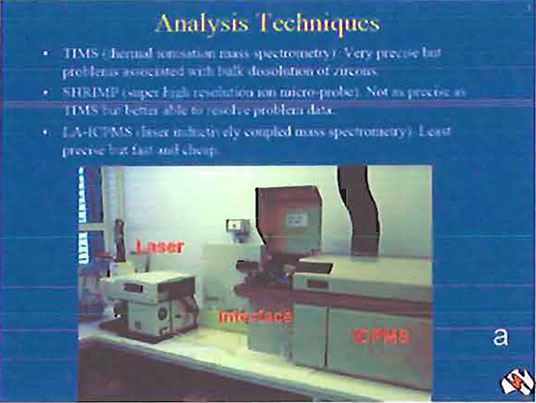 |
Fig. 6.1. (a) LA ICP-MS
|
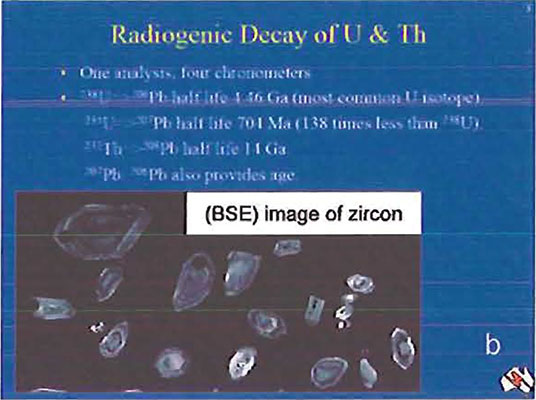 |
| Fig. 6.1. (b) BSE image of zircon crystals |
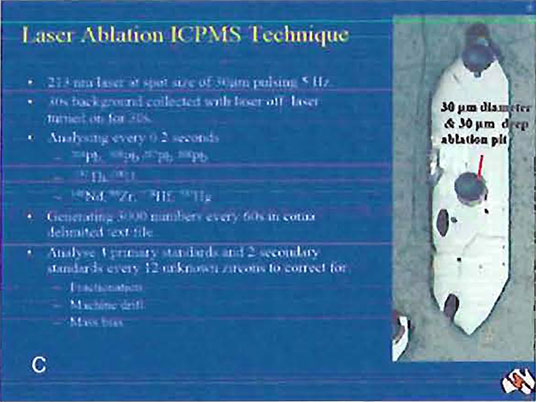 |
Fig. 6.1. (c) LA ICP-MS technique
|
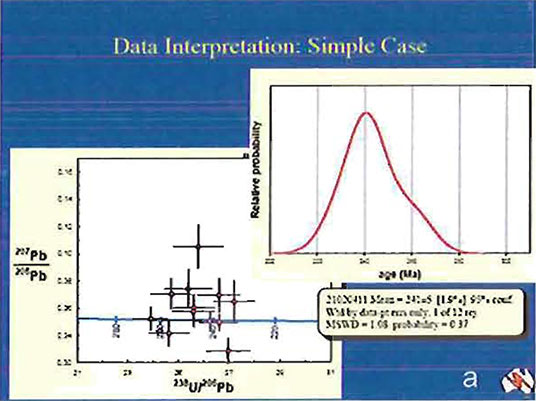 |
| Fig. 6.2. (a, b, c) Data interpretation processes of zircon dating in LA ICP-MS and SHRIMP techniques |
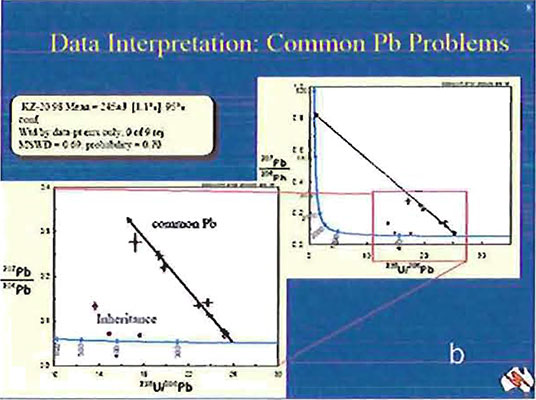 |
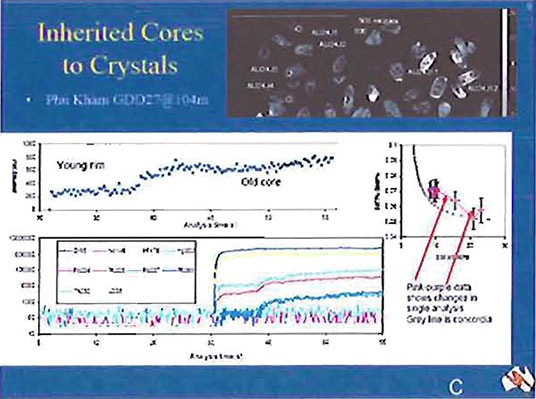 |
The initial Pb correction for total Pb in each analysis was done by removing initial 206Pb, 207Pb and 208Pb using the observed 204Pb and assuming Pb of Broken Hill isotropic composition. However, as common Pb is present in all ion microprobe Pb isotropic analyses it is necessary to correct for this by using either the non-radiogenic Pb isotope (204Pb) or making corrections based on 208Pb or 207Pb. Correction using the 204Pb isotope (4f206%) are most commonly applied, particularly for Precambrian samples. This correction was made for each analysis by using the measured 204Pb/206Pb and assuming the 204Pb/206Pb from the common Pb.
Note that LA ICP-MS zircon dates are cost effective and accurate. Most of the problems with the data relate to the complex chemistry of the zircons rather than analytical problems. Accuracy of the dates are continuously assessed using standard zircons. These are almost always within error of SHRIMP and TIMS dates.
6.3 Geochronology of Igneous Rocks of Mogok Area
In the present study, the igneous rocks (15 samples) were analyzed from the area, but some rock samples such as peridotite and urtite are generally lacking in zircon and some biotite microgranite, pegmatite and sapphire-bearing syenite pegmatite are very poor in zircon content. So, they are quite difficult for dating by LA ICP-MS technique. Only four samples were analyzed at Tasmania University, Australia.
The first was from an outcrop of quartz syenite showing foliation in the north of Ohn-gaing, beside the Mogok-Bernard-myo motor road, 22° 56' 28.2" N, 96° 29' 43.5" E. The zircon is being analyzed and processed at SHRIMP centre at University of Western Australia by Prof. Bark Barley. As with most analyses of oscillatory zoned zircon cores [it was dated as of] Crataceous and Jurassic age. The distinct rim type generally gives a mean Mid. to Late Eocene (30–45 Ma) and thus probably represents zircon recrystallization during the high grade metamorphic event (metamorphic age). Consequently their mean age of 25 Ma (Late Oligocene) is the best estimate emplacement age (igneous zircon age) of the syenite from this area.
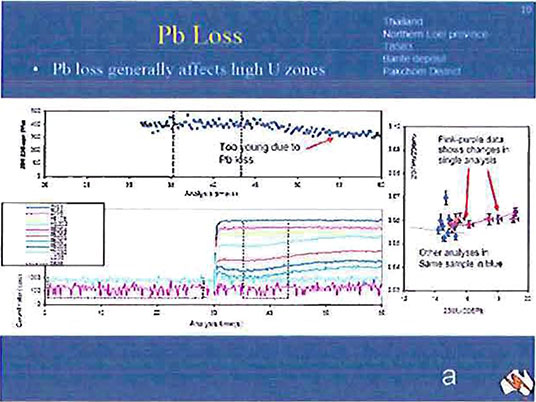 |
| Fig. 6.3. (a,b) Data interpretation processes of zircon dating in LA ICP-MS and SHRIMP techniques. |
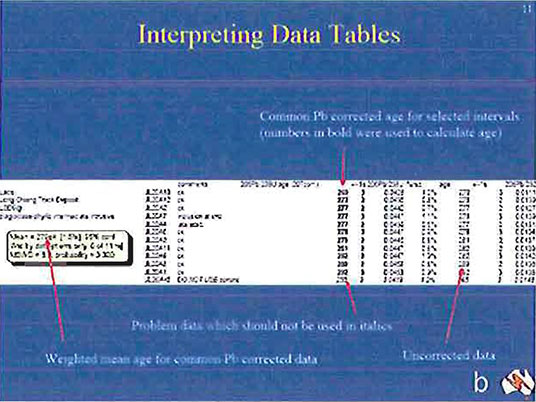 |
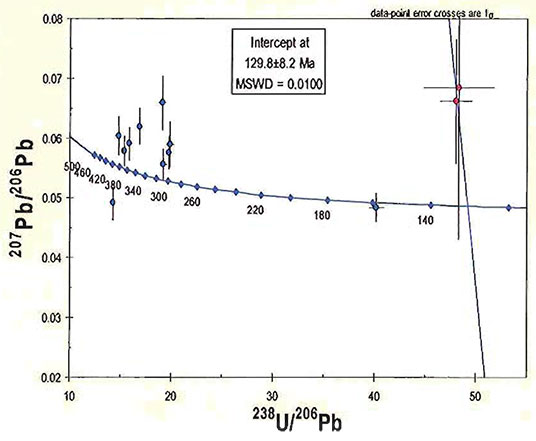 |
| Fig. 6.4. The concordia plot diagram of radiometric dating of augite-biotite granite (A-2) by LA ICP-MS technique. |
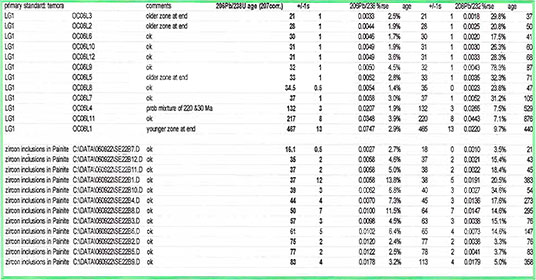 |
| Table 6.1. LA ICP-MS: U-Pb zircon age data for leucogranite (LG-1) and zircon inclusion in painite, associated with ruby in leucogranite matrix (P-1). (Click to enlarge) |
The second sample (LG·1) was from the foliated leucogranite in Ohn-bin-ywe-htwet, east of Mogok, 22° 56' 32" N, 96° 32' 10" E. The zircon gave unsubstantiated (467±13 Ma) Ordovician (could be error), from the core to Late Triassic–Jurassic, again to Oligocene–Miocene (32–21 ±1 Ma) in igneous age.
The third sample (A-2) was from the foliated augite-biotite granite in Taung-me Taung peak, 22° 58' 18.4" N, 96° 28' 8.5" E. The radiometric age of zircon gives 129.8± 8.2 Ma (Early Cretaceous).
Also, a painite sample (P-1) from the contact zone of leucogranite and marble, associated with ruby in leucogranite matrix in the Wet-loo mine, 22° 54' 28.5" N, 96° 23' 34.9" E, was analyzed. The core zone of zircon gave Late Cretaceous (83±4 Ma), and the other zone shows Eocene (44±4 Ma) to as young as Miocene (16.1±0.5 Ma). So, it can be postulated that the formation of ruby with painite in contact metamorphism was associated with this age (Miocene; 16.1 ±0.5 Ma).
However, three radiometric dates provided in some previous works should also be mentioned: uranothorianite-bearing pegmatite: 15 Ma (Middle Miocene) and Kabaing Granite: 16 Ma (Middle Miocene) (Searle and Haq, 1964); 15.8±1.1 Ma (Middle Miocene) (Bertrand et al., 2001).
6.4 Age of Mogok Metamorphism
The age of metamorphism of the Mogok Metamorphic Belt (MMB) and the age of the metamorphic rocks at Mogok have been studied and discussed by numerous geologists as follows:
La Touche (1913), Iyer (1953), Searle and Haq (1964), Bender (1983) regarded the age of metamorphism of the Mogok Metamorphic Belt as Precambrian to Paleozoic.
Searle and Haq (1964) proposed that the metamorphic rocks of the Mogok Series are equivalent to the Silurian Mawchi Series: the Jurassic coal bearing series (Clegg, 1941), the Cretaceous Orbitolina-bearing limestone of Mogok (Heron, 1937). These authors considered the age of metamorphism as Cenozoic.
A sample of biotite microgranite (Kabaing Granite) rocks was radiometrically analyzed by the Union of Burma Atomic Energy Centre in the 1960s and their age was determined (~16.3±0.6 Ma). The age of metamorphism was estimated ~40 Ma (Late Eocene) based on radiometric dating of phlogopite samples from Mogok.
Maung Thein (2000) considered that the regional metamorphism of the Mogok Metamorphic Belt might have occurred during (Late Oligocene) in relation to the middle phase of Himalayan Orogeny.
Bertrand et al. (2001) analyzed high grade metamorphic rocks and foliated intrusive rocks collected along the Mogok Metamorphic Belt (biotite, muscovite and phlogopite samples from granites, marbles, gneiss and mica schists). The 40Ar – 39Ar and 40Ar – 40Ar methods used in testing biotite samples collected at the Mogok area indicated the age for the metamorphism near Gwe-bin (~15.8 ±1.1 Ma), at Mogok municipality (~16.5 ±0.6 Ma), east of Pyant-gyi (~17.4 ± 0.6 Ma), and at the north bank of the Nam-pai river, near the village of Mong-Iong (~19.5 ±1.0 Ma).
Mica samples from the northern Shan scarp (Mandalay area), Sagaing fault (Sagaing area) and southern Shan scarp (Thaton area) gave the average age for the metamorphism (~21.2, ~17 and ~26.2 Ma respectively). Thus, the age of the Mogok Metamorphic Belt metamorphism is suggested to be from ~26.2 to ~15.8 Ma (Oligocene to Middle Miocene).
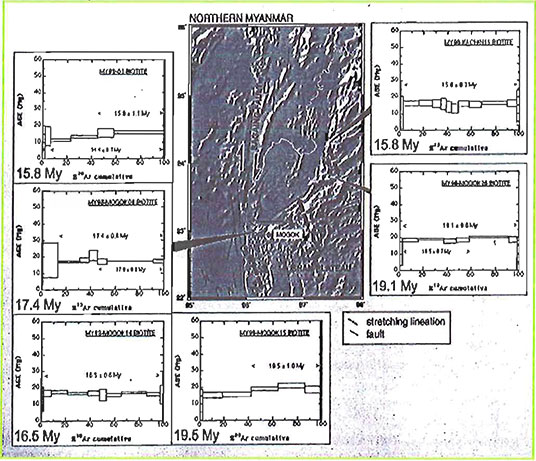 |
| Fig. 6.5. Location map and 40Ar/39Ar diagrams of dated samples from high grade metamorphic and intrusive rocks of Mogok area. All the ages from this area are Early to Middle Miocene (after Bertrand et al., 2001). |
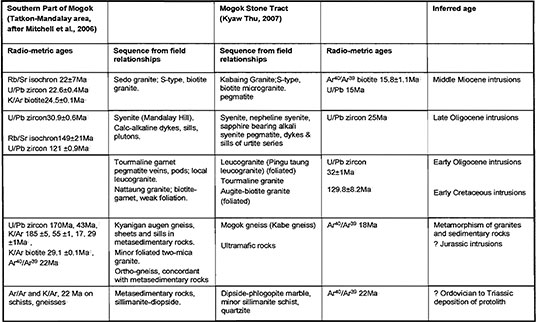 |
| Table 6.2. Comparison of rock sequence in southern part of Mogok Stone Tract and the study area with radiometric ages. (Click to enlarge) |
Thus conclude Chapters V and VI. Access Chapter VII here.
References follow.
References
Adams, E.D., 1926. A visit to the gem districts of Ceylon and Burma. Bull. Can. Inst. Min. Met. v. 166, pp. 213–246.
Barley, M.E, A.L. Pickard, Khin Zaw, P. Rak and M.G. Doyle, 2003. Jurassic to Miocene magmatism and metamorphism in the Mogok metamorphic belt and the Indian-Eurasia collision in Myanmar. Tectonics, v.22, no.3, pp. 1–11.
Bender, F. 1983. Geology of Burma. Gebruder Borntraeger, Berlin, 293 pp.
Bertrand, G, C. Rangin, H. Maluski, Tin Aung Han, Myint Thein, Ohn Myint, Win Maw and San Lwin, 1999. Cenozoic metamorphism along the Shan scarp (Myanmar): evidences for ductile shear along the Sagaing fault or the northward migration of the eastern Himalayan syntaxis. Geophysical Research Letters, v. 26, pp. 915–918.
Bertrand, G., C. Rangin, H. Mluski, H. Bellon and GIAC Scientific Party, 2001. Diachronous cooling along the Mogok Metamorphic Belt (Shan scarp, Myanmar): the trace of the northward migration of the Indian syntaxis. Journal of Asian Earth Sciences, v.19, pp. 649–659.
Brown, C.B. and J.W. Judd, 1896. The rubies of Burma and associated minerals; their mode of occurrence, origin and metamorphoses: a contribution to the history of corundum. Philosophical Transaction of the Royal Society of London. Series A, v. 187, pp. 151–228.
Brook, M., and N.J. Snelling, 1976. K/Ar and Rb/Sr age determinations on rocks and minerals from Burma. Inst. Geol. Sci., London, Isotope Geol. Unit Report 76/12, p.20.
Buddington, A.F., 1959. Granite emplacement with special reference to North America, Geol. Soc. Am. Bull., v. 70. pp. 671–747.
Cerny, P., 1991. Rare-element granitic pegmatite: regional to global environments and petrogenesis. Geosci. Can., v. 18, pt. 2, pp. 68–81.
Chappell, B.W. and A.J.R. White, 1974. Two contrasting granite types. Pacific Geol., v. 8, pp. 173–174.
Clegg, E.L.G. 1941. The Cretaceous and associated rocks of Burma. Mem. Geol. Surv. India, v. 74, pt.1, 101 pp.
Cobbing, E.J., P.E.J. Pitfield, O.P.E. Darbyshire and D.J.J. Mallick, 1992. The granites of the South-East Asian tin belt. Overseas Memoir, British Geological Survey, London, no. 10, 369 pp.
Fermor. L.L., 1932. The Mogok Stone Tract, Katha District. Rec. Geol. Surv. India, v. 65, pt. 1, pp. 80–86.
Hatch, F.H, A.K. Wells and M.K. Wells, 1961. Petrology of the igneous rocks, Thomas Murby, London, 514 pp.
Heron. A. M., 1937, Age of Mogok series, Rec. Geol. Surv. India, v. 72, pt. 1, pp. 62–64.
Hla Kyi, T. Themelis and Kyaw Thu, 2005. The pegmatitic gem deposits of Molo (Momeik) and Sakhan-gyi (Mogok). The Australian Gemmologist, v. 22, no. 7, pp. 303–309.
Hutchison, C.S., 1975. The norm, its variations, their calculation and relationships. Sch. Min. Pet., Mitt., v. 55, pp. 243–256.
Hyndman, D.W, 1985. Petrology of igneous and metamorphic rocks. New York, McGraw-Hill. 2nd edt., 786 pp.
Irvine, T.N. and W.R.A. Barager, 1971. A guide to the chemical classification of the common volcanic rocks. Can. Jour. Earth Sci., v. 8, pp. 523–548.
Iyer, L.A.N., 1953. The geology and gemstones of the Mogok Stone Tract, Burma. Mem. Geol. Surv. India, v. 82, pp. 100.
Kerkvoort, G.V., 1995. Rare metal granitic pegmatites. Unpublished B.Sc. Hons. Thesis, University of Tasmania, Australia, 70 pp.
Khin Zaw, 1986. Geological, petrological, and geochemical characteristics of granitoid rocks in Burma: with special reference to the emplacement of W-Sn mineralisation and their global tectonic implications. Unpublished research paper.
Khin Zaw, 1998. Geological evolution of selected granitic pegmatites in Myanmar (Burma): constraints from regional setting, lithology, and fluid-inclusion studies. International Geology Review, v. 40, pp. 647–662.
La Touche, T.H.D., 1913. Geology of the northern Shan States. Mem. Geol. Surv. India, v. 39, pt. 2, 379 pp.
Maniar, P.D., and P.M. Piccoli, 1989. Tectonic discrimination of granitoids. Geol. Soc. Am. Bull., v. 101, pp. 635–643.
Marmo, A., 1956. On the emplacement of granites. Amer. Jour. of Sci., v. 254, pp. 479–492.
Maung Thein, 2000. Summary of the geological history of Myanmar. Unpublished paper, p.8.
Metcalfe, I., 1998. Origin and assembly of South-East Asia continental terranes. In: Audley Charles, M.G., Hallam, A. (Eds.), Gondwana and Tethys, Special publication Geological Society of London, v. 37, pp. 101–118.
Metcalfe, I., 2000. The Bentong-Raub suture zone. Journal of Southeast Asian Earth Sciences, v. 18, pp. 691–721.
Mitchell, A.H.G., 1977. Tectonic setting for emplacement of Southeast Asia Tin granites. Geological Society of London, v. 141, pp. 123–140.
Mitchell, A.H.G., 1992. Late Permian-Mesozoic events and the Mergui Group nappe in Myanmar and Thailand. Jour. of SE Asia Earth Sciences, v. 7, pp. 165–178.
Mitchell, A.H.G., 1993. Cretaceous-Cenzoic tectonic event in western Myanmar (Burma)—Assam region: Jour. of the Geol. Soc. London, v. 150, pp. 1089–1102.
Mitchell, A.H.G., C.A. Ausa, L. Deiparine, Tin Hlaing, Nyunt Htay and Aung Khine, 2004. The Modi Taung-Nankwe gold district, Slate Belt, central Myanmar: mesothermal veins in a Mesozoic orogen. Journal of Asian Earth Sciences, v. 23, pp. 231–341.
Mitchell, A.H.G., Myint Thein Htay, Kyaw Min Htun, Myint Naing Win, Thura Oo and Tin Hlaing, 2006. Rock relationships in the Mogok metamorphic belt, Tatkon to Mandalay, central Myanmar. Jour. of Asian Earth Sciences. doi:10.1016/j.jseaes.2006.05.009, pp.1–20.
Myint Lwin Thein, Ohn Myint, Sun Kyi and Phone Nyunt Win, 1990. Geology and stratigraphy of the metamorphosed Early Paleozoic rocks of the Mogok-Thabeikkyin-Singu-Madaya areas. Unpublished staff report, no. 98, A.G.D., Y.U., p.24.
O’connor, J.T., 1965. Classification of quartz-rich igneous rocks based on feldspar ratios. U.S.G.S. Prof. Paper. 525B, pp. 79–84.
Piwinskii, and P.J. Wyllie, 1970. Experimental studies of igneous rock series: felsic body suite from the Neddle point pluton, Wallowa Batholith, Oregon. Jour. Geol. v. 78, pp. 52–76.
Ridd, M.F., 1971. South-East Asia as a part of Gondwana land. Nature, v. 234, pp. 531–533.
Rossman, G.R., Saw Naung Oo, G.E. Harlow and J. Hunt, 2005. A second source in Myanmar and metasomatic origins. Goldschmidt Conference Abstract, Geochemistry of Gem Deposits Sec., pp. 278–279.
Searle, D.L. and Ba Than Haq, 1964. The Mogok belt of Burma and its relationship to the Himalayan orogeny. in Int. Geol. Cong., Twenty-Second Sec., India, Himalayan and Alpine orogeny, Sec. 11, pp. 132–161.
Sein Myint, Than Naing and Soe Nyunt Swe, 1979. Satellite imagery interpretation of major lineaments in part of northeastern Burma. Contribution to Burmese Geology, v. 1, no. 1. pp. 20–25.
Smirnov, V.I., 1976. Geology of mineral deposits. MIR Publishers, Moscow, 520 pp.
Sutherland, F.L., D. Schwarrz, E.A. Jobbins, R.R. Coenraads and G. Webb, 1998. Distinctive gem corundum suites from discrete basalt fields: a comparative study of Barrington, Australia, and West Pailin, Cambodia gem fields. Journal of Gemmology, v. 26, pp. 65–85.
Sylvester, P. J., 1989. Post-collision alkaline granites. Jour. of Geol., v. 97, pp. 261–280.
Thet Tin Nyunt, 2000. Mineralogical and petrological studies of Bemard-Pyaunggaung area, Mogok Township, Mandalay Division. Unpublished M.Sc. Thesis, University of Yangon, 184 pp.
Thuzar Aung, 2003. Petrology and Gemstones of Ondan and its Environs, Mogok Township, Mandalay Division. Unpublished M.Res. Thesis, University of Yangon, 90 pp.
Tuttle, O. F., and N.L. Bowen, 1958. Origin of granite in the light of experimental studies in the system NaAISip8-KAISiP8-Si02-H20. In: Hyundman, D.W., 1985. Petrology of igneous and metamorphic rocks. New York, McGraw-Hill. 2nd edt., 786 pp.
United Nations, 1978. Geology and exploration geochemistry of the Shan scarps area, east of Kyaukse, Thazi and Tatkon, central Burma. Technical Report. UN/BUR 721002, no. 3, United Nations Development Programme, New York.
Washington, H.S., 1917; Chemical analyses of igneous rocks published from 1884 to 1913, inclusive. U.S. Geol. Survey Prof. Paper, no. 99, pp. 9–1201.
Wiebe, R.A., 1974. Differentiation in layered diorite intrusions, Ingonish, Nova Scotia. Jour. Geol., v. 82, pp. 731–750.
Williams. H., F.J. Turner and C.M. Gilbert, 1982. Petrography; an introduction of the study of rocks in thin section. 2nd ed. W.H. Freeman and Co., San Francisco, 626 pp.
Win Naing, 2001. Tertiary deformation patterns of the northeastern part of Myanmar: structural and microfabric evidences from the Mogok-Momeik area. Unpublished M.Res. Thesis, Dept. of Geol., University of Yangon 198 pp.
Wright, J.B., 1969. A simple alkalinity ratio and its application to questions of non-orogenic granite gneiss. Geol. Mag., v. 106, pp. 523–548.